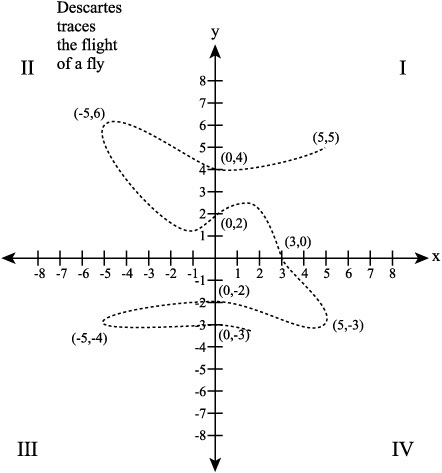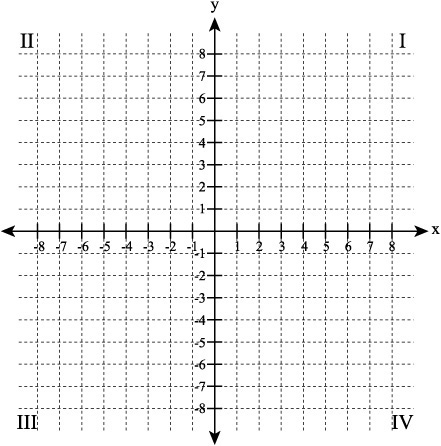Cartesian Coordinates
When Rene Descartes (1596–1650) invented the system of mapping coordinates that bears his name, he was lying ill in bed, watching a fly negotiate the space above him. To be able to determine the location of the fly as it buzzed above him, Descartes imagined a flattened world in which the fly moved around on a plane that roughly corresponded in dimensions to the ceiling.
To make it so he could trace the path of the fly on the plane, the mathematician drew axes that divided the ceiling area into four quadrants. He labeled the quadrants using Roman numerals, as shown in Figure 4.9. At the intersection he placed the origin of his mapping. The axes he divided into equal segments identified with positive and negative values. The vertical axis he labeled as the y axis. The horizontal axis he labeled as the x axis.
Figure 4.9. The Cartesian coordinate system makes it possible to map a domain to a range.

The horizontal axis of the Cartesian plane represents domain values. The x axis of the Cartesian plane represents range values. Each point on the Cartesian plane is a coordinate, and each coordinate consists of an ordered pair of values. The x value always occurs first in an ordered pair. The y value always occurs second.
Mathematicians sometimes refer to the first number in an ordered pair as the abscissa. They sometimes refer to the second number as the ordinate. Each number is a coordinate. The ordered pair designates a point within the quadrants of the coordinate system. At the center of the system, where the two axes intersect, you find the origin of the system.
If you picture the system upright, the quadrants of the Cartesian plane are set up so that quadrant I is in the upper right. You then move counter-clockwise through the quadrants. Quadrant II is on the top left. Quadrant III is on the bottom on the left. Quadrant IV lies on the bottom on the right. If you trace the flight of the fly, you can discern that the positive and negative values of the ordered pairs take on a specific pattern. Table 4.1 provides a summary of this pattern.
Exercise Set 4.3Here is a Cartesian coordinate system with a grid to help you position ordered pairs. Use the system to determine the quadrant in which the ordered pairs belong.
|

